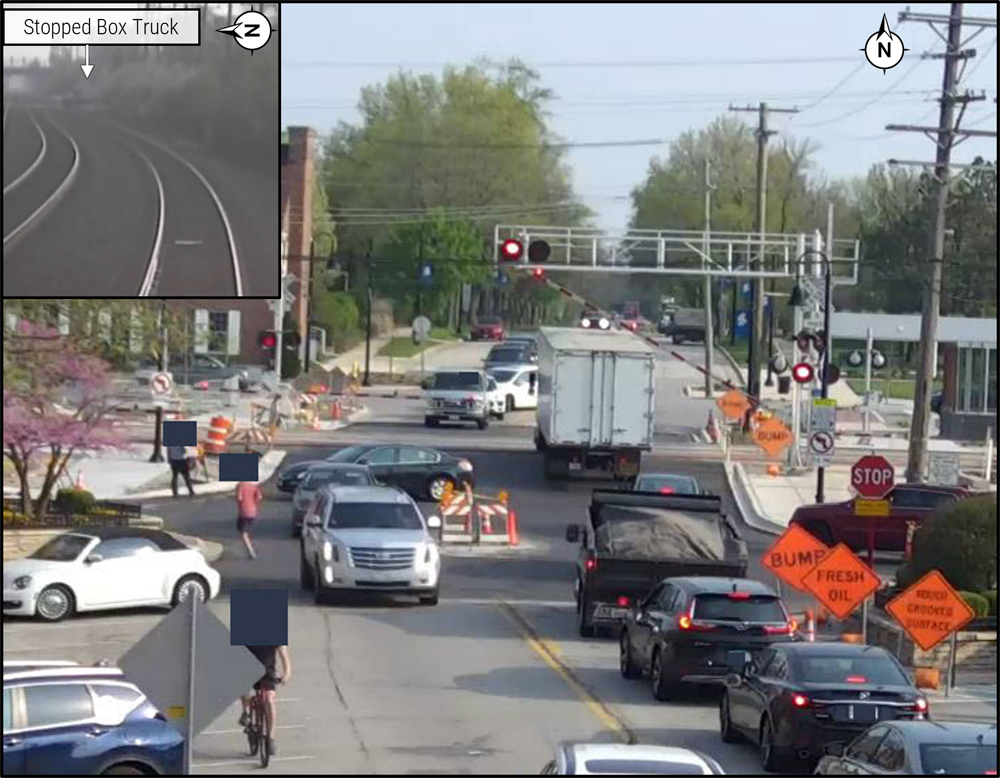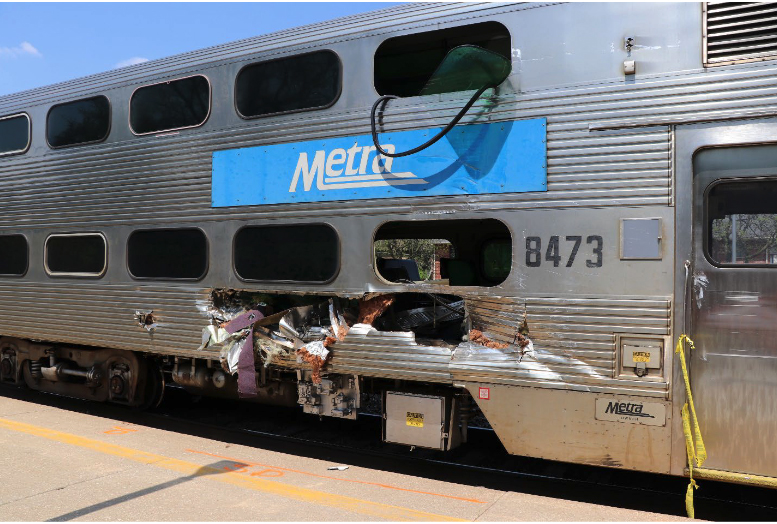
WASHINGTON — The actions of an improperly licensed truck driver were the probable cause of a fatal grade-crossing collision involving a Metra commuter train in Clarendon Hills, Ill., in May 2022, with the trucking company’s inadequate safety policies contributing to the incident, the National Transportation Safety Board has determined in its final report.
The incident on May 11, 2022, led to the death of a Metra passenger ejected through a railcar window and injuries to four other people on board the train [see “Chicago’s Metra passenger killed …,” Trains News Wire, May 12, 2022]. It was only the second accident involving a passenger in Metra history and the first since 2005; the victim was later identified as 72-year-old Christina Lopez of Downers Grove, Ill.

The collision occurred at 8:16 a.m. at the Prospect Avenue grade crossing in Clarendon Hills, and involved inbound Metra BNSF line train No. 1242. The truck it hit had stalled as it encountered a short 6% grade and approximate 2-inch drop-off between pavement and tracks at the crossing, where road work was in progress. The driver was unable to restart the vehicle; he and two other occupants were able to get out of the truck before it was hit by the train, which was going 55 mph, having slowed from 69.8 mph after initiating emergency braking. The truck was pushed to one side, significantly damaging one side of the train’s cab car; the truck then caught fire. Many of the details of the collision became public when the NTSB released the accident docket investigation earlier this year [see “Metra train hit stalled truck …,” News Wire, May 18, 2023].
The driver, a 54-year-old male, said he had learned to drive trucks while in the military in Yugoslavia, but did not have a commercial driver’s license and told an NTSB interviewer that he had never had one. He was driving with an expired medical certificate, having failed to follow up after reporting a 2019 heart attack during his 2020 renewal exam. He also did not undergo required post-accident alcohol or drug testing because the trucking company did not have a program for such testing in place.
The truck’s owner, Del’s Moving, did not have written policies for safe vehicle operation, seat belt use, cell phone use, or other safety policies; had no training program and no program to document personnel records such as licenses and medical certificates; did not have a controlled substance or alcohol policy or testing program as required by federal regulations; and did not keep required vehicle maintenance records. The company eventually paid a $10,000 fine and submitted a corrective action plan to the Federal Motor Carrier Safety Administration to address the issues.
The NTSB’s analysis determined that the passenger’s death was from the impact of the truck with the side of the cab car and not with the ejection from the car, and that the impact likely exceeded the railcar’s sidewall strength requirements. The report notes the NTSB has previously recommended that the Federal Railroad Administration develop side-impact crashworthiness standards and update federal regulations accordingly; that recommendation is still open.
Other results of the incident saw the Commercial Vehicle Safety Alliance, an industry group, update its recommended procedures for law-inforcement roadside inspections to require confirmation of a appropriate commercial driver’s license. Also, the city of Clarendon Hills addressed the drop-off at the grade crossing with temporary paving repairs; the road work at the crossing was completed June 26, 2022, and provides a roadway flush with the grade crossing.














It’s not at all surprising that this driver did not have a CDL, and it’s a little surprising so much was made of that issue. Medium-duty trucks like the one in the picture are frequently marketed as “non-CDL” and are registered under 26,000# GVW, so they attract small business owners who either can’t or won’t hire CDL drivers and pay them accordingly. A CDL is required to operate a truck registered over 26,000#, hauling hazmat, or a passenger-carrying vehicle.
Del’s Moving sounds like a typical small business. It’s not surprising to hear that it didn’t have a comprehensive driver training/safety/compliance program in place, either, not at all uncommon with small trucking businesses. Anyway, there’s precious little difference between CDL and non-CDL trucks of this size.
But a truck that stalls and won’t re-start at a 2-inch pavement transition must be in pretty poor repair to start with, or is being driven by an inept driver, or both. Whatever, it’s a recipe for disaster.
In any case, a $10,000 fine is a pretty light punishment considering the damage to all kinds of property and the loss of a life. It’s likely there is still a hefty lawsuit or two in Del’s future. But that’s the chance you take when you hire unqualified labor and are careless about the operation of commercial motor vehicles.
Anyone know if driver/company were charged criminally?
Having some knowledge of trucking in the Chicago area I would have to guess that this was a one or two truck operation operating on a shoe string. The owners probably don’t have a clue as to regulations. And why did they hire a driver without a CDL?
The admonition: “one gets what he pays for”, comes to mind. Whoever had goods in the transit truck (cause of accident/death) sought this company because…..probably, cheap. Why would it cost more else where? The “cost more” is due to the price of being qualified/safe/liable. endmrw2112231040
Left unexplained is why the truck stalled and why it couldn’t be restarted. Lots of violations but most of them don’t appear to directly contribute to the accident. Still, they are indicative of the safety culture, or lack thereof, at the company. I wonder if they truck had unresolved maintenance issues.
Apparently a human life is only worth $10K when it’s a trucker causing the accident…
I hope they sue that trucking company out of existence. This is ridiculous they could get by with this many law / rule infractions! Also, $10,000 is a stupid low amount of money for such a fine.
Wow. $10,000.00 seems quite low for the result of the accident, but it is likely what is defined in the law.
That’s the civil fine, which seems very very low. Amtrak and BNSF and METRA can sue for damages. whatever those may be.